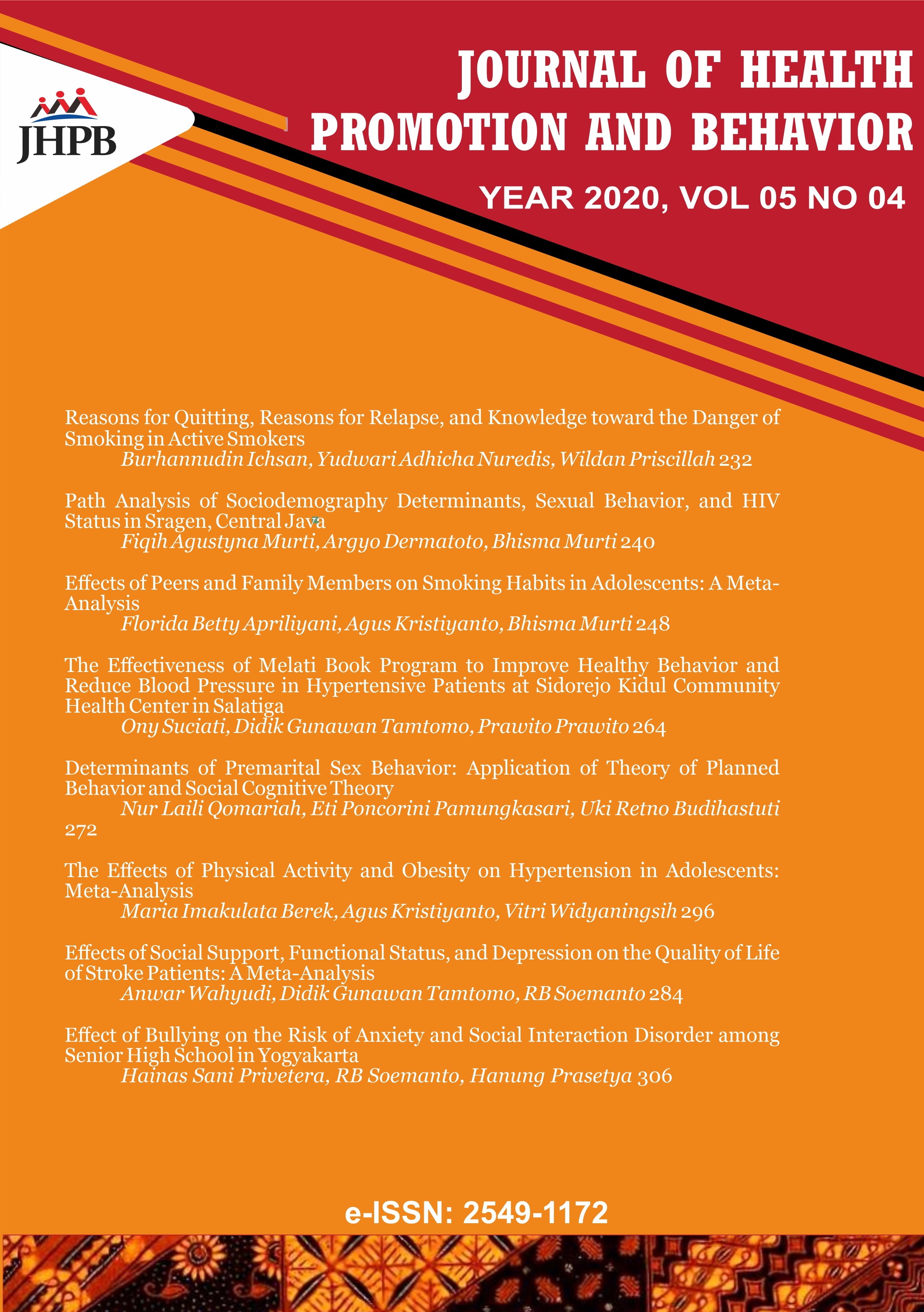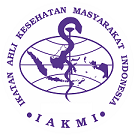Effect of Bullying on the Risk of Anxiety and Social Interaction Disorder among Senior High School in Yogyakarta
Abstract
Background: Bullying is a widespread phenomenon among young people and is used to describe interpersonal relationships characterized by an imbalance of power. The Indonesian Child Protection Commission noted that there were 161 cases of bullying in 2018. Adolescents who are involved in bullying experience risks such as psychiatric symptoms, alcohol and drug abuse and even suicide. This study aims to analyze the effects of bullying on self-concept and social disorders in high school students in Sleman Yogyakarta.
Subjects and Method: This study used a cross sectional study design. This study was conducted in Sleman Regency in August 2019. The sample was taken by using stratified random sampling with a total of 200 senior high school students. The independent variables include parental education, social environment, anxiety level, self-concept, and social interaction disorders. The dependent variable was bullying behavior. Data were collected using a questionnaire. Data were analyzed by using multilevel multiple logistic regression with stata 13.
Results: Low family education (b= 3.11; 95% CI= 0.83 to 3.67; p= 0.002), social environment in the city (b=3.15; 95% CI= 0.71 to 3.09; p= 0.002), have social media (b=4.13; 95% CI= 1.46 to 3.83; p= 0.000), have a level of anxiety (b= 2.92; 95% CI= 0.62 to 3.17; p= 0.005), negative self-concept (b=2.83; 95% CI= 0.62 to 3.40; p= 0.005), social interaction disorder (b= 3.23; 95% CI= 0.87 to 3.55; p= 0.001) increased the likelihood of experiencing bullying in adolescents. Variations at the school level indicated that there was a contextual influence on bullying behavior (ICC= 13.18%).
Conclusion: There is a statistically significant influence of parental education, social environment, social media, anxiety levels, self-concept, and social interaction disorders on bullying behavior in adolescents. Variations at the level of school show that there is a contextual influence on bullying behavior in adolescents.
Keywords: bullying, adolescents, multilevel analysis
Correspondence: Hainas Sani Privetera. Masters Program in Public Health, Universitas Sebelas Maret. Jl. Ir. Sutami 36A, Surakarta 57126, Central Java. Email: sariprivitera@gmail.com. Mobile: +6282328848001.
Journal of Health Promotion and Behavior (2020), 05(04): 306-316
https://doi.org/10.26911/thejhpb.2020.05.04.08.
How to Cite
References
Albuhairan F, Abbas OA, Sayyed DE, Badri M, Alshahri S, Vries ND (2017). The relationship of bullying and physical violence to mental health and aca-demic performance: A cross-sectional study among adolescents in Kingdom of Saudi Arabia. Int J Pediatr Adolesc Med. 4(2): 61-65. http://dx.doi.org/-10.1016/j.ijpam.2016.12.005.
Almahasnih AFS (2019). The phenomenon of bullying: A case study of Jordanian Schools at Tafila. World Journal of Education. 9(1). https://doi.org/10.-5430/wje.v9n1p243.
Brito CC, Oliveira MT (2013). Bullying and self-esteem in adolescents from public schools. J Pediatr (Rio J). 89(6): 601-607. http://dx.doi.org/10.1016/j.jped.-2013.04.001.
Craig W, Boniel-Nissim M, King N, Walsh SD, Boer M, Donnelly PD, Harel-Fisch Y, et al. (2020). Social media use and cyber-bullying: A cross-national ana-lysis of young people in 42 countries. 66(6): S100-S108. J Adolesc Health. https://doi.org/10.1016/j.jadohealth.2020.03.006.
Erick M, Kristi K, Juan C (2014). School bullying, cyberbullying, or both: correlates of teen suicidality in the 2011 CDC Youth Risk Behavior Sur-vey. Compr Psychiatry. 55(5): 1063-8 https://doi.org/10.1016/j.comppsych.2014.02.005.
Festl R, Quandt T (2013). Social relations and cyberbullying: The influence of individual and structural attributes on victimization and perpetration via the internet. Human Communication Re-search. 39(1): 101–126. https://doi.org/10.1111/j.1468-2958.2012.01442.x.
Garett R, Lord LR, Young SD (2016). Asso-ciations between social media and cyberbullying: A review of the litera-ture. MHealth. 2(46). http://dx.doi.-org/10.21037/mhealth.2016.12.01.
Liu J, Graves N (2011). Childhood bullying: A review of constructs, contexts, and nursing implications. Public Health Nurs. 6(3): 379–390. https://doi.org-/10.1111/j.1525-1446.2011.00972.x.
Karatas H, Ozturk C (2011). Relationship between bullying and health problems in primary school children. Asian Nursing Research. 5(2): 81-87. https:-//doi.org/10.1016/S1976-1317(11)60-016-9.
Kemenkes (2016). Peran keluarga dukung kesehatan jiwa masyarakat. Available at: http://www.depkes.go.id/article/-print/16100700005/peran-keluarga-dukungkesehatan-jiwa-masyarakat.html (Accessed July 2019).
Kowalski RM, Limber SP (2013). Psycholo-gical, physical, and academic corre-lates of cyberbullying and traditional bullying. J Adolesc Health. 53(1): S13–S20. https://doi.org/10.1016/j.-jadohealth.2012.09.018.
Marcillo C, Ramos-Olazagasti MA, Blanco C, Sala R, Canino G, Bird H, Duarte CS (2015). Socio-cultural context and bulling others in childhood. J Child Fam Stud. 24(8): 2241–2249. https:-//doi:10.1007/s10826-014-0026-1.
Martinez-Monteagudo MC, Delgado B, Ingles CJ, Escortell R (2020). Cyber-bullying and social anxiety: A latent class analysis among Spanish adoles-cents. Int J Environmental Res Public Health. 17: 406. https://doi:10.3390-/ijerph17020406.
Maunder R, Crafter S (2018). School bully-ing from a sociocultural perspective. Aggression and Violent Behavior. 38: 13-20. https://doi.org/10.1016/j.avb.-2017.10.010.
Notar CE, Padgett S, Roden J (2013). Cyberbullying: A review of the litera-ture. Universal Journal of Educational Research. 1(1): 1-9. DOI: 10.13189/uj-er.2013.010101.
Ortega-Baron J, Buelga S, Cava MJ (2015). The influence of school and family environment on adolescent victims of cyberbullying. Comunicar Media Edu-cation Research Journal. https://www.revistacomunicar.com/index.-php?contenido=detalles&numero=46&articulo=46-2016-06&idioma=en.
Pradas ICL, Romera EM, Casas JA, Ruiz RO (2017). Cybergossip and cyber-bullying during primary school years. Psicología Educativa. 23: 73–80. http://dx.doi.org/10.1016/j.pse.2017.05.007.
Saiz MJS, Chacon RMF, Abejar MG, Parra MDS, Rubio MEL, Jimenez SY (2019). Personal and social factors which protect against bullying victimization. http://dx.doi.org/10.6018/eglobal.18.2.345931.
Wolke D (2017). Prevalence and consequ-ences of bullying: What could health-care services do for intervention. European Psychiatry. 41: S25. https://doi:10.1016/j.eurpsy.2017.01.132.
Xantus A, Saltz SB, Shaw JA (2015). The relationship between social media bullying and the adolescent's self report of emotional health: A study of urban youth on an acute inpatient psychiatric unit. J Depress Anxiety. 4(2): 186. https://doi:10.4172/2167-1044.1000186.





